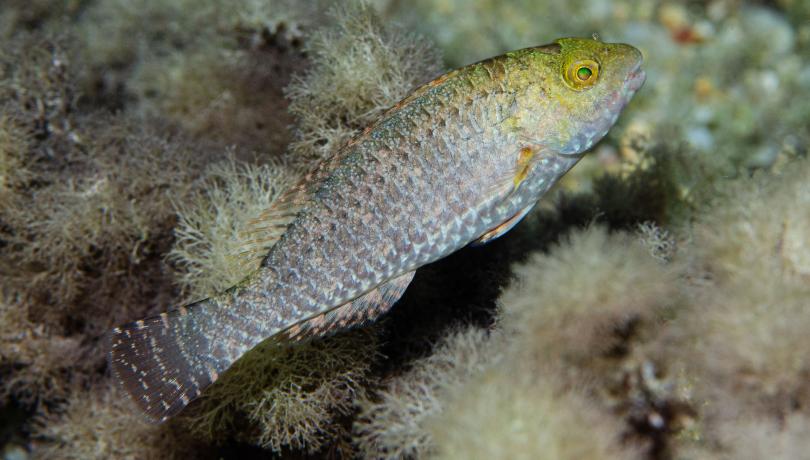These are the major findings of BioMARató, a citizen science event coordinated by ICM-CSIC that mobilized over 480 volunteers to survey the biodiversity of the Catalan coast over six months.

The BioMARató has detected, for the first time in Catalonia, the Canary parrotfish (Sparisoma cretense), observed in Blanes, and the fireworm (Hermodice carunculata), a marine polychaete that can grow up to 30 centimeters and has urticating bristles on its body, found in the SES Underwater Park of Tarragona. These are two tropical and subtropical species that highlight the warming of the Catalan coast. This citizen science event celebrated its fourth edition this year with a total of 91,211 observations, 1,731 species, and over 480 participants, which has helped document other indicator species of climate change and altered biological cycles, such as premature ovulation in gorgonians or early blooming of Posidonia.
The initiative, which records all observations on the citizen science platform MINKA, has collaborated with entities like the Catalan Federation of Underwater Activities (FECDAS), the Oceánicos Association, Plàncton Diving, and Anèl·lides - Serveis Ambientals Marins, organizing snorkeling and scuba diving photography outings across the provinces of Girona, Barcelona, and Tarragona.
A new invasive algae species of Asian origin reaches Catalonia
Mobilizing amateur underwater photographers also led to identifying and documenting the invasive Asian algae Rugulopteryx okamurae, detected for the first time in Catalonia at the port of Llançà by a team from the University of Barcelona's Pharmacology department. It was later found outside the port in Farella and subsequently reported to MINKA when a participant spotted it at the Port of Colera.
"We still don't know its full distribution, but finding it in three different places in Alt Empordà in a short time suggests its range could be broader. It is already invasive in the Strait of Gibraltar and Andalusia, but in Catalonia, it will need monitoring to assess its impact,” says Xavier Salvador, biologist at ICM-CSIC and MINKA technician.
Tropical species and altered biological cycles
The event has also allowed for gathering evidence of typical warm-water species detected on the Catalan coast. The Bermuda chub (Kyphosus saltatrix), registered in Tarragona's SES Park, is a clear example.
“Although it had been previously observed in Catalonia, there are very few records as it’s hard to spot,” Salvador highlights. Another similar case is the purple sea star (Ophidiaster ophidianus), of subtropical origin and rare in Catalonia, observed in Ametlla de Mar. “It is widely distributed from the southern peninsula to the Balearic Islands, but it’s very rare in Catalonia,” Salvador explains.
“The advantage of having hundreds of eyes underwater observing fauna and flora is that we can capture important biological processes of some species that show the effects of climate change,” says Jaume Piera, ICM-CSIC researcher and coordinator of BioMARató. For example, in Llafranc, it was observed that the red gorgonian (Paramuricea clavata) is ovulating early, and in Ametlla de Mar, it was confirmed that Posidonia oceanica begins flowering nearly two months earlier than usual. Another indication of warming waters is coral bleaching, seen in a case of Mediterranean madrepore (Cladocora caespitosa) in Tossa de Mar, a phenomenon that inhibits these organisms’ reproduction, leading to their death.
It hasn’t gone unnoticed that 2024 was the year of the rays. During BioMARató, more than 15 observations of the pelagic stingray (Pteroplatytrygon violacea) were recorded in MINKA, including in the Barcelona area. This species, usually living in the open sea, is increasingly approaching the coast to find calm waters to breed, driven by warming seas. Although they’re not dangerous, their presence led to several beach closures. In contrast, other rays, like the undulate ray (Raja undulata), are affected negatively by warm water, as they’re becoming less common in Catalonia.
Citizen science helps document rarities
Other rare or curious phenomena observed through citizen participation include the flowering of Cymodocea nodosa in Ametlla de Mar, a rare and difficult event to see. Specimens of the lined false barnacle (Conchoderma virgatum), an infrequent species, were also observed on floating objects on the Costa Brava. One BioMARató participant documented a white ascidian (Rhopalaea neapolitana), typically found in deeper waters. Lastly, a juvenile basking shark (Cetorhinus maximus) was observed incidentally caught in Ametlla de Mar, a species of interest for studying its migration patterns and juvenile recruitment.
A celebration to close BioMARató 2024
The Volunteer Party will occur on November 9 at the Fishing Interpretation Center (CIP) in Ametlla de Mar, gathering the scientific team from ICM-CSIC, collaborating entities, and participants from across Catalonia. With four editions of BioMARató completed, over 2,300 different species have been recorded along the Catalan coast on MINKA. This participatory observatory has the highest density of verified coastal and marine biodiversity data in Spain and the most comprehensive in the Mediterranean. Currently, it has over 250,000 verified marine observations along the Catalan coast, all open-access data available to the scientific community. BioMARató is funded by the European projects MINKE, ANERIS, ECS, and GUARDEN.